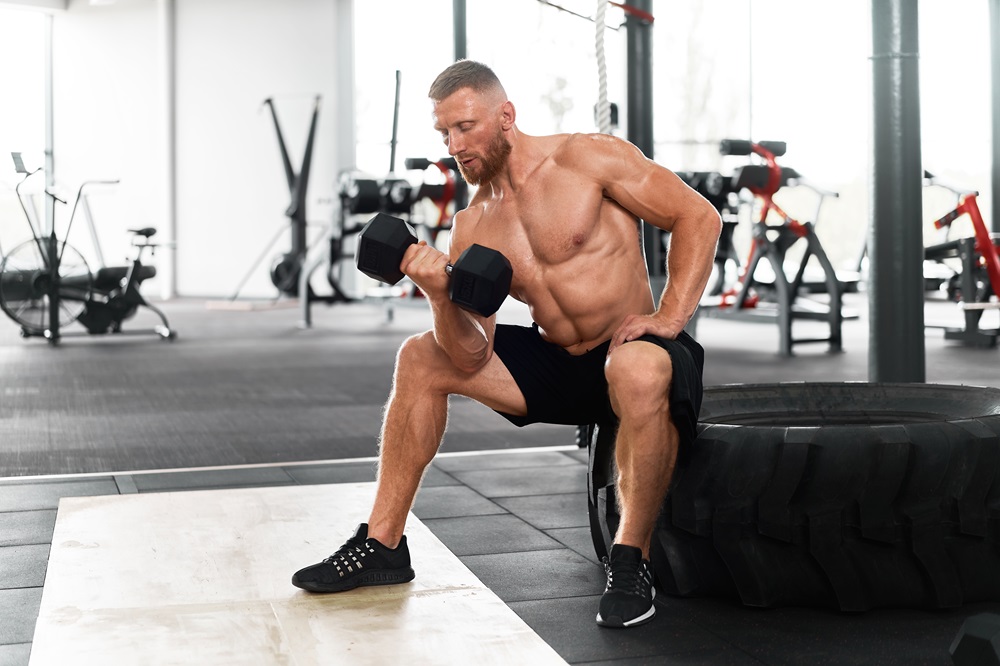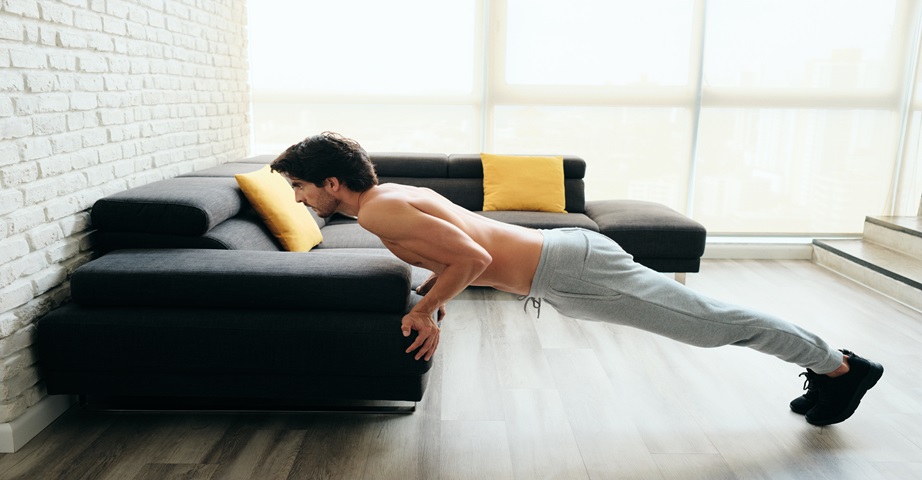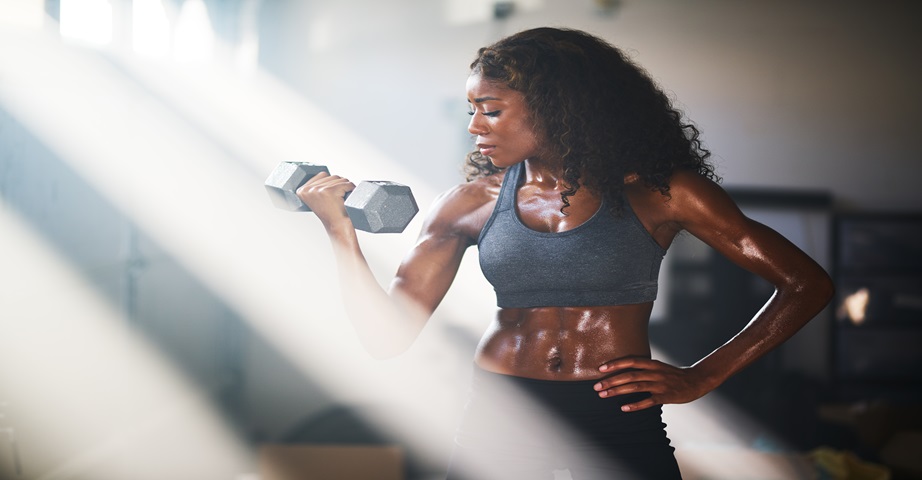Exercises for biceps - how to train the biceps of the arm?

Biceps are a small muscle parts, which is considered an attribute of strength and masculinity, being an important element of the sculpted figure and the dream of many people who decide to strength training. Thus, the build of the two-headed muscles of the arms is often treated as a priority among enthusiasts of an active lifestyle. What are the best exercises for the biceps? Is it possible to do the biceps exercises without equipment?
Summary
What is biceps? - Anatomy and construction of biceps
Biceps is a two-joint muscle, also known as the biceps muscle of the arm, which is responsible, among others, for flexing in the elbow joint, as well as for raising the arm, turning inward and abduction.
The biceps consists of two heads - a short head, which is located on the inside of the arm, and the place of its beginning is the scapula styloid process, and a long head, which can be found on the outer side of the shoulder, where it comes out of the supraspinatus tubercle of the scapula and the shoulder girdle. Both heads end with a common tendon, which is located on the tuberosity of the radial bone. Directly under the biceps is the shoulder muscle, which supports the biceps muscle of the arm in bending the elbow joint, and additionally affects the supination, that is, reversing the forearm.
Biceps training - rules
Before you start thinking about what exercises for the biceps it is worth doing and how to arrange the right training plan for the biceps, it is worth exploring the basic principles of proper training of the two-headed muscles of the arm.
The first, extremely important step before starting intensive exercise is to conduct an appropriate warm-up, which will prepare the muscles for demanding physical effort, warm up the body and reduce the risk of injuries and damage. A good solution for the start can be to perform several series of low-intensity exercises with the use of a small load.
When the body and muscles are already warmed up, it is worth focusing on the correct technique when performing exercises. It is the right technique during physical exercise that allows you to work on specific muscles, without unnecessary involvement in the movement of other muscle parts, and also reduces the risk of unwanted injuries. When lifting weights, the back should be straightened and the hands should be in the right starting position, while the elbows - relatively close to the body.
The next step before starting the proper training of the biceps is to choose the right load. Do not start with high weights, because the body needs time to adapt and conform to the load used. Therefore, when starting the adventure with strength training and biceps exercises, it is worth reaching for less weight first and gradually, along with the progress in training, increase the load used. A helpful indicator may be the number of repetitions that you are able to perform during one series of exercises - a well-matched weight allows you to perform about 8-15 repetitions.
When planning the build of the biceps, it is important to include in the training plan not only isolated exercises, focusing strictly around the biceps muscle, but also multi-joint exercises, strengthening various muscle parts. During the activity, it is also extremely important to practice various exercises and train the biceps in different arm settings, which will enable comprehensive development of the biceps muscles of the arm.
Recommended products during the building of biceps
How to exercise biceps?
People who care about the build of muscle mass, and for whom the development of biceps is important, often wonder how much exercise for biceps to perform and how often to plan workouts. It is difficult to answer these questions unequivocally, because the number of series and repetitions, the selection of exercises and their frequency are really issues depending on the level of advancement and training goals of the athlete.
Beginner lovers of strength sports should focus primarily on performing multi-joint exercises, and during the entire training to perform 1-2 exercises aimed at the development of the biceps. In turn, slightly more experienced athletes can perform exercises for the two-headed muscles of the arms 2-3 times a week.
It seems optimal to perform 10-20 series for a given muscle part per week, but remember to divide the exercises performed on the two-headed muscles of the arms into several training units, with breaks lasting 24-72 hours, which will enable optimal building of muscle mass and reduce the risk of muscle overload and thus their injuries. It is also important to use the load during training, which should be tailored to the athlete, depending on the athlete's body weight, as well as the training period and the type of activity performed. People who want to develop muscle mass should use 80-90% of the maximum weight during physical exercise while reducing the number of repetitions of the exercise performed during one series.
Exercises for biceps at home - 5 exercises for biceps without professional equipment
Sculpted muscles and big biceps are usually associated with frequent visits to the gym. However, biceps training can also be done at home, using your own body weight or flat equipment. What are the best biceps exercises without equipment? What home exercises for the muscles of the biceps can be helpful during the building of the biceps muscle?
- Push-ups
- Raising arms with load
- Exercise with a towel
- Bending the shoulders on the build the elbow on the knee
- Pull-up with supinated grip on the edge of the table
Commonly used home exercise for the biceps are push-ups, both in the classic version and in various variants. When training biceps, you can do diamond push-ups, also called narrow ones, which consist of holding your hands close to each other so that the fingers and thumbs of the hands touch each other, forming a diamond shape. A good idea may also be push-ups in the back support, during which the hands should be base on the platform, and the elbow joints should be bent back, or push-ups on the so-called dog - to make them, you should straddle, place your feet and hands on the ground, and then lower your body down while lifting your head up. Then you should return to the starting position and repeat this exercise several times.
In house conditions, you can use water bottles for the load. Just stand in a slight straddle and raise your arms up, holding a liquid-filled bottle in your hands. It is important to keep your head straight while exercising and pulled off your shoulder blades.
Have we already mentioned that you do not need professional equipment for biceps exercises? It turns out that you just need a strong towel and a solid door, possibly a tree in front of the house. Hang the towel over the handle (or tree limb) and grab it from two sides, balking your knee-bent legs, then bow and bend your hands in your elbows, pulling on the towel.

Sit comfortably and rest your hand on your thigh, while holding a bottle of water in your hand. Then straighten and bend your hand, keeping in mind the control and fluidity of the movement.
The table also is a graceful piece of equipment during home biceps training. It is enough to go under the table with your head, grab the piece of furniture with supinated grip, and the bent legs base the ground, then pull up the body and lower it to the starting position.
Exercises for biceps with dumbbells
Exercises for the biceps can be performed at home also with additional equipment. Very well work out, both during training in the flat and in the gym, the dumbbells that do not take up much space, and can have a beneficial effect on the development of the two-headed muscles of the arms. Biceps training with dumbbells can be practised by doing exercises such as:
- dumbbell paddling with inclined torso,
- lifting forearms in the hammerer grip during standing,
- bending of the forearm with a dumbbell,
- bending dumbbells based on knee,
- alternating bending of forearms with dumbbells,
- bending of forearms with dumbbells to the sides.
Exercises with dumbbells can also be performed with variety, e.g. along with training or weight bands. However, it is worth remembering, to use additional equipment only when you master the correct technique of performing basic versions of exercises for the two-headed muscle of the arm.

Exercises for biceps at the gym
Effective biceps training should combine multi-joint exercises with isolated exercises. A good solution may be to perform training at the gym, where access to professional equipment is unlimited, and the possibilities of practising various types of activities on the two-headed muscles of the arm really large. The best biceps exercises performed at the gym take into account various body settings and allow for comprehensive development of the desired muscles.
In the training plan, it is worth taking into account multi-joint exercises, such as paddling the barbell, chin-up or pulling up with a neutral grip. In turn, isolated exercises should be included in the training activities, such as:
- Bending forearms with dumbbells on a bench - during exhalation, raise the arm holding the dumbbell with supinated grips towards the shoulder, while tightening the biceps and resting the back and head on the bench. In the upper position, it is necessary to stand 1-2 seconds, and then with the inhalation it is necessary to return to the starting position;
- Bending the forearms with a barbell while standing - you should stand in a slight straddle and hold the barbell at the height of the hips with the pronated grip. With the exhalation, the barbell should be raised towards the shoulders, while tightening the biceps, and when inhaling it should be returned to the starting position;
- Bending the forearms on the lower lift - you need to stand in front of the lift with feet spaced to the width of the hips, then slightly bend the knees and grab the bar. With the exhalation, you need to raise the bar to the shoulders, directing the elbows to the side and tightening the biceps. With the inhalation you should slowly lower your hands;
- Bending the arms with dumbbells on the preacher bench - sitting on the preacher bench you should lean your elbows and straighten your back, and then hold the dumbbells close to the chin, keeping the arms bent at the elbows. When inhaling, you should lower your forearms with the weight on the preacher bench, and return to the starting position with the exhalation.
It is worth remembering that the biceps are a small muscle part, which is why isolated exercises and training methods should be selected with extreme caution, focusing on this, in order not to lead to overtraining of the body and increase the risk of injury.
The crucial when strengthening and expanding the two-headed muscles of the arm is the proper fit and gradual increase of the load, so pay attention to the training plan, which always should be individually tailored to the capabilities and needs of the athlete.

